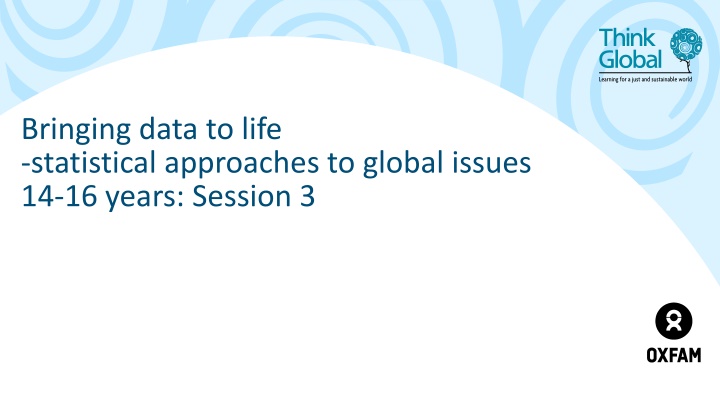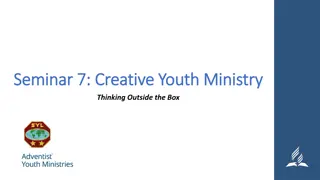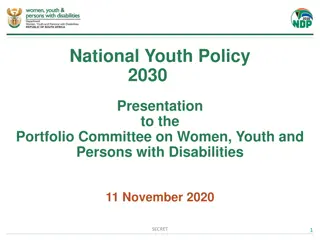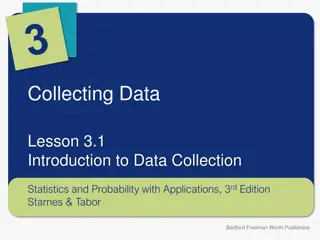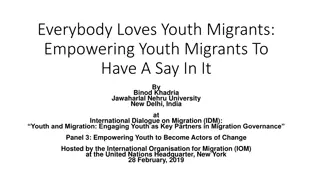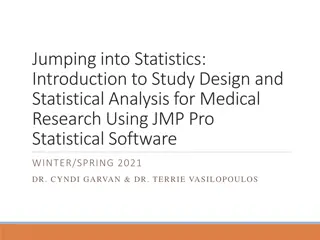Statistical Insights into Global Issues for Youth
Statistical approaches to global issues through pie charts and histograms in the context of women's collective action research. Analyze data on marital status in Mali and Ethiopia, life expectancies, and honey production experience in Ethiopia. Learn about interpreting data visualizations and frequency density to better understand the presented information.
Download Presentation

Please find below an Image/Link to download the presentation.
The content on the website is provided AS IS for your information and personal use only. It may not be sold, licensed, or shared on other websites without obtaining consent from the author.If you encounter any issues during the download, it is possible that the publisher has removed the file from their server.
You are allowed to download the files provided on this website for personal or commercial use, subject to the condition that they are used lawfully. All files are the property of their respective owners.
The content on the website is provided AS IS for your information and personal use only. It may not be sold, licensed, or shared on other websites without obtaining consent from the author.
E N D
Presentation Transcript
Bringing data to life -statistical approaches to global issues 14-16 years: Session 3
Womens Collective Action research Photo Credit: Oxfam
Pie charts Look at the marital status pie charts for Mali and Ethiopia in front of you. Consider the following questions. How many people in Ethiopia are married? How many are widowed? Are there more married women in Ethiopia?
Examining Pie charts Look at the marital status pie charts for Mali and Ethiopia again. One of these countries has a life expectancy of 58. The other has a life expectancy of 62. Which life expectancy do you think belongs to each country? What issues are there with comparing the data from the pie-chart with national statistics?
Histograms Here is a table and histogram showing the years of experience each woman (non-member) has producing honey in Ethiopia Frequency Years of Experience 0 ? < 5 Frequency 136 5 ? < 10 132 10 ? < 15 93 15 ? < 25 94 25 ? < 50 42 Years of Experience The bars have been plotted so that the widths match the class intervals but there is a problem! The last class interval now looks as though it should have the most people in it because it has the biggest area!
Histograms In fact, only 42 women out of the 497 asked had over 25 years experience producing honey in Ethiopia. Frequency Years of Experience 0 ? < 5 Frequency 136 5 ? < 10 132 10 ? < 15 93 15 ? < 25 94 25 ? < 50 42 Years of Experience We need to change the bars so that it is the area of the bar that represents the number of people in it.
Histograms To do this, we need to create another column called Frequency Density . Frequency Density is the Frequency divided by the class width. Frequency Density (F ??) Years of Experience 0 ? < 5 5 ? < 10 10 ? < 15 15 ? < 25 25 ? < 50 Frequency 136 132 93 94 42 Class Width Class width is the difference between the top and the bottom of the class interval. For example, 0 ? < 5 has a difference of 5 so this is our class width.
Histograms To do this, we need to create another column called Frequency Density . Frequency Density is the Frequency divided by the class width. Frequency Density (F ??) Years of Experience 0 ? < 5 5 ? < 10 10 ? < 15 15 ? < 25 25 ? < 50 Frequency 136 132 93 94 42 Class Width 5 5 5 10 25 Class width is the difference between the top and the bottom of the class interval. For example, 0 ? < 5 has a difference of 5 so this is our class width.
Histograms To do this, we need to create another column called Frequency Density . Frequency Density is the Frequency divided by the class width. Frequency Density (F ??) 27.2 26.4 18.6 9.4 1.68 Years of Experience 0 ? < 5 5 ? < 10 10 ? < 15 15 ? < 25 25 ? < 50 Frequency 136 132 93 94 42 Class Width 5 5 5 10 25 Class width is the difference between the top and the bottom of the class interval. For example, 0 ? < 5 has a difference of 5 so this is our class width.
Histograms Histogram showing years of experience of non-WCA members in Ethiopia The histogram is right skewed towards the lower end. This means most of the data is found closer to zero than fifty. Frequency Frequency Density (F ??) 27.2 Years of Experience Class Width 5 Freq. 136 0 ? < 5 132 5 26.4 5 ? < 10 93 5 18.6 10 ? < 15 94 10 9.4 15 ? < 25 Years of Experience 42 25 1.68 25 ? < 50 When we plot our bars, we see that they much better represent the frequencies of the years of experience the women have making honey!
Histograms Use your worksheet to create your own histogram. Instead of the WCA non-members, you will be looking at the WCA members. Which group would you expect to have more experience? Why?
Histograms This is the table you have on your worksheet. It shows the years of experience each woman (WCA member) has producing honey in Ethiopia. Years of Experience Frequency Density Frequency Class Width 92 0 ? < 5 66 5 ? < 10 38 10 ? < 15 40 15 ? < 25 7 25 ? < 50
Histograms This is the table you have on your worksheet. It shows the years of experience each woman (WCA member) has producing honey in Ethiopia. Your table should look like this Years of Experience Frequency Density Frequency Class Width 92 5 18.4 0 ? < 5 66 5 13.2 5 ? < 10 38 5 7.6 10 ? < 15 40 10 4 15 ? < 25 7 25 0.28 25 ? < 50
Histograms Histogram showing years of experience of WCA members in Ethiopia Years of Experience Frequency Class Width Frequency Density Frequency Density 92 5 18.4 0 ? < 5 66 5 13.2 5 ? < 10 38 5 7.6 10 ? < 15 40 10 4 15 ? < 25 7 25 0.28 25 ? < 50 Years of Experience
Histograms What comparisons can you make between the histogram we created as an example (years of experience of non-members in Ethiopia) and the histogram you have drawn on your worksheet (years of experience of WCA members)? Both of the histograms show a right skewed distribution, meaning the data is mostly on the left. Why is it difficult to make comparisons?
Years of Experience - Non WCA Ethiopia Years of Experience - WCA Ethiopia 0 x<5 0 x<5 5 x<10 5 x<10 10 x<15 10 x<15 15 x<25 15 x<25 25 x<50 25 x<50
Summary Activity In front of you are some cards that need grouping together. There is no set number that go together. Match up as many as you can!
